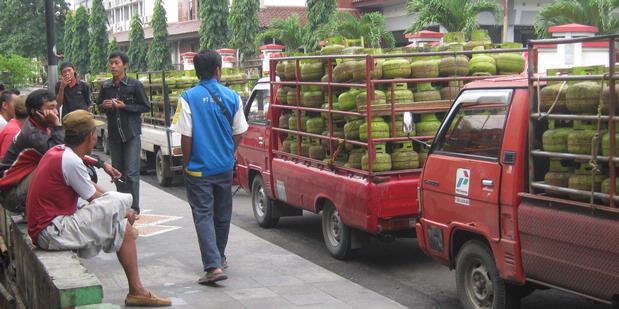These are some of the headlines from local news in Indonesia for the past couple of days:
- LPG (of type 3 kilogram) is Scarce in Majalengka (Friday, February 3, 2012 via seputar-indonesia.com - in Indonesian)
- Supply Interrupted Due To Bad Weather, LPG is Scarce in Lombok (Friday, February 3, 2012 via detiknews.com - in Indonesian)
- LPG (of type 3 kilogram) is Scarce in Kendal (Thursday, February 2, 2012 via kompas.com - in Indonesian)
- LPG is Scarce in Palopo (Wednesday, February 1, 2012 via tempo.co - in Indonesian)
 |
| LPG sub-agents queuing at LPG distributor agents in Kendal, Central Java (via kompas.com) |
From Kerosene to Liquefied Petroleum Gas (LPG)
Over US$6 million is budgeted by the Indonesian government every year to subsidize oil fuel in the form of kerosene, low-octane petrol, diesel fuel and LPG for household consumers. Kerosene receives the largest amount of subsidies (over 50% of the budgeted funds for oil fuel is spent for kerosene).
Kerosene is majorly used by lower class household consumers in rural areas of the country, in which the population is mostly composed of. Most of them relied on kerosene as a main source of fuel for cooking because it is cheap. Since it is affordable, people became dependent on kerosene. This is causing trouble for the government because global oil prices are rising and consequently inflating the government's budget.
As a solution, in 2007 the government established a program to convert household consumers from using kerosene to LPG. LPG is also subsidized, but not as much as kerosene. In short, the government can save a lot of money by diverting household consumption to LPG.
Apart from that, converting to LPG triggers the growth of equipments industry for LPG related appliances, such as stoves and gas cylinders. Growth of industry means growth of employment, which subsequently helps the economic development.
 |
| Kerosene to LPG conversion program (via pertamina.com) |
Challenges in Supply Chain
5 years since the deployment of the kerosene to LPG conversion program, problems are starting to arise. Pertamina (State Oil and Natural Gas Mining Company), as the sole producer of LPG in Indonesia, are facing problems in their supply chain. As described in some of the news headlines, LPG in some areas of the country are scarce. Demand for LPG in these areas are not fulfilled.
Looking at some of the areas mentioned above, they are not concentrated in a particular region of the country. Majalengka and Kendal are both located in the populous island of Java. Majalengka is a regency located in the western part of Java, while the location of Kendal is in the central. Lombok and Palopo on the other hand, are located in the eastern area of Indonesia, which is not as populous as Java. Lombok is an island in the south east of Indonesia, while Palopo is a regency in the island of Sulawesi in the north east. This shows that location has little to do with the shortage of supply in LPG.
One area of supply chain of LPG that are facing some problems is shipment. In the case of Lombok and Palopo, bad weather was the main reason for the insufficient supply of LPG to those areas. Ships were unwilling to sail because it was too risky. Pertamina did not anticipated the interruption of shipment, as a result, LPG in Lombok and Palopo were short in supply because the stock of LPG in these areas were depleted while demand were constantly growing.
In the case of Kendal, one of the reasons for the lack of LPG mentioned in the article was the sudden increase in demand. At one point, plenty of people were using wood to cook. Then came the rainy season. Those who were still using wood to cook are now finding it hard to find dry wood to burn. Because of that, they had to switch to LPG. In this case, weather did not interrupt the shipment process. However, it suddenly increased the demand for LPG, while the amount of stock of LPG did not change.
 |
| Two large tankers filling up petrol and LPG at one of Pertamina's depot in Tanjung Uban, Bintan island, the province of Riau islands. Petrol and LPG from this depot are shipped and distributed to the island of Java. (via antarafoto.com) |
Forecasting is key
Planning demand and supply in a supply chain is vital. Pertamina could have done better in preventing the LPG scarcity problem had they predicted variables such as the weather. However, that is the problem, weather these days are unpredictable.
Alternatively, Pertamina could have made use of weather forecasting technologies to at least have a better estimation of what may happen in the future. After all, it is the welfare of the people at stake.
Sources:
- http://www.seputar-indonesia.com/edisicetak/content/view/466195/
- http://us.detiknews.com/read/2012/02/03/153615/1833649/10/pasokan-terganggu-karena-cuaca-buruk-elpiji-langka-di-lombok?utm_source=twitterfeed&utm_medium=twitter&utm_campaign=Feed%3A+detik%2FkgMZ+%28detikNews%29
- http://regional.kompas.com/read/2012/02/02/16421489/Elpiji.3.Kilogram.Langka.di.Kendal
- http://koran.tempo.co/konten/2012/02/01/263245/Elpiji-Langka-di-Palopo
- http://gasdom.pertamina.com/produk_dan_services_elpiji_konversi.aspx
Your case study is a very good example of how importantly an external factor (weather) affect the efficiency of Supply Chain.
ReplyDeleteI still remembered the price of baby milk suddenly jump high when Japan was hit by the earthquake and affected by the nuclear crisis.
And another example was the Hard Disk market under pressure because the Supply from Thailand was badly damaged and delayed due to flood.
Thank you for your article!